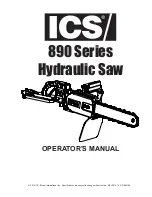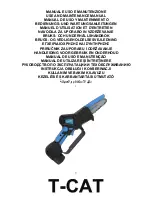
2
English
GB
FR
DE
ES
IT
NL
PT
DK
SE
FI
NO
RU
PL
CZ
HU
RO
LV
LT
EE
HR
SI
SK
GR
TR
OPERATION
PLUNGE CUTTING (Fig. 6)
Follow these directions to plunge cut:
Q
Secure the workpiece to a work bench or table with a
vise or with clamps.
Q
Make sure the saw blade is clear of any foreign
material and that the power cord and extension cord
are out of the blade path.
Q
Hold the saw firmly in front of and clearly away from
you.
Q
Mark the line of cut clearly.
Q
Choose a convenient starting point inside the cutting
area and place the tip of the blade over that point.
Q
Rest the front edge of the shoe assembly on the
workpiece and hold it firmly in position during the cut.
Q
Depress the trigger switch and allow the saw blade to
reach full cutting speed.
WARNING
Make sure the blade does not touch the workpiece
until the motor reaches full speed. Faillure to heed
this warning can cause you to lose of control of
the saw and result in serious injury.
Q
Tilt the saw downward until the tip of the blade starts
cutting the workpiece.
Q
Allow the saw to penetrate the workpiece.
Q
Tilt the saw until the blade is perpendicular to
the workpiece.
WARNING
Blades longer than 15.2 cm can whip and should
not be used for plunge cutting. Failure to heed
this warning can resut in serious personal injury.
WARNING
Cutting into electrical wiring can cause the blade,
the blade clamp, and the saw bar assembly to
become electrically live. Do not touch metal parts
when cutting into a wall; grasp only the insulated
surfaces on the tool. Make sure hidden electrical
wiring, water pipes, and mechanical hazards are
not in the blade path when cutting into a wall.
METAL CUTTING (Fig. 7)
You may cut metals such as sheet steel, pipe steel rods,
aluminum, brass, and copper with your saw. Observe the
following tips when metal cutting:
Be careful not to twist or bend the saw blade.
Q
Do not force the tool.
Q
Use cutting oil when cutting soft metals and steel.
Cutting oil also keeps the blades cool, increases
cutting action, and prolongs blade life.
Q
Never use gasoline since normal sparking of motor
could ignite fumes.
Q
Clamp the worpiece firmly and cut close to the
clamping point to eliminate any vibration of the work.
When cutting conduit pipe or angle iron, clamp the
workpiece in a vise if possible and cut close to the vise.
To cut thin sheet material, “sandwich” the material
between hardboard or plywood and clamp the layers
to eliminate vibration and material tearing.
Q
Always keep firm pressure on the base to hold it
securely against the workpiece.
ENVIRONMENTAL PROTECTION
Recycle raw materials instead of disposing
as waste. The machine, accessories and
packaging should be sorted for en-
vironmental-friendly recycling.
SYMBOL
The following show the symbols used for the tool. Be
sure that you understand their meaning before use.
V.................................................................................Volts
Hz..............................................................................Hertz
.........................................................Alternating Current
W...............................................................................Watts
n
o
................................................................No load Speed
min
-1
.....................Revolutions or reciprocation per minute
.........................................................Double Insulati
..........................................Read instruction manual
.......................Wear Personal protective equipment
.................................Recycle raw materials
instead of disposing as waste. The machine,
accessories and packaging should be sorted for
environmental-friendly recycling.
Summary of Contents for ERS-80V
Page 2: ...1...























